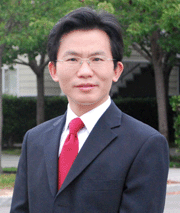Dr. Linyou Cao
North Carolina State University

2D Materials and Heterostructures: From Scalable Synthesis to A New Age of Atomic-scale Catalysis and Photonics
102 Cardwell Hall
December 8, 2014
4:30 p.m.
Two-dimensional (2D) transition metal chalcogenide (TMDC) materials in forms of monolayer or fewlayer have recently emerged as a topical research area. Unlike graphene, which is gapless by nature, 2D TMDC materials present an attractive semiconductor option at the atomic scale and promise to open up an age of atomic-scale semiconductor technology. In this presentation, I will try to address three important questions about 2D TMDC materials, including
a. How to grow the atomically thin 2D TMDC materials in controlled and scalable ways?
b. How to transfer a large-scale 2D TMDC materials from one substrate to another without compromising the quality?
c. What kind of new opportunites could be enabled by 2D TMDC materials in catalysis and photonics?
I will start this presentation with introducing a unique self-limiting chemical vapor deposition process that we have developed for the synthesis of centimeter-scale, high quality, and uniform MoS2 films with precisely controlled layer numbers. I will then show a unique surface energy-assisted transfer technique that can perfectly transfer the synthesized centimeter-scale films onto arbitrary substrates without compromising the quality. I will also show our results on the new functionality of 2D MoS2 for catalysis and photonics. We have demonstrated layer-dependent catalytic activities in 2D MoS2 for the hydrogen evolution reaction. We have also demonstrated efficient interfacial charge transfer in both epitaxial and non-epitaxial MoS2/WS2 heterostructures and that the refractive index of 2D MoS2 over the entire visible range is dominated by excitonic effects